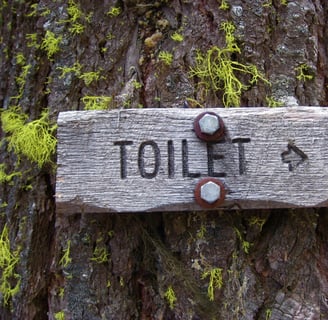Trail Hygiene
How to stay clean on the trail, while also avoid making a mess.
3/14/20252 min read


Maintaining proper hygiene while backpacking in the backcountry is essential for both personal health and environmental responsibility. Without access to modern conveniences like running water and soap dispensers, hikers must be diligent about cleanliness to prevent illness and minimize their impact on the wilderness. One of the most critical aspects of backcountry hygiene is managing food and dishwashing properly to avoid contamination, wildlife attraction, and environmental harm.
Backcountry dishwashing requires a thoughtful approach to ensure that food residue does not attract animals or pollute natural water sources. The first step is to use minimal dishware, opting for a single pot or bowl and a lightweight utensil to simplify cleaning. After eating, all food scraps should be packed out to prevent attracting wildlife. Washing dishes should be done at least 200 feet away from any water source to prevent contamination. Using biodegradable soap is recommended, but even biodegradable soap should be used sparingly and never directly in a stream or lake. Instead, backpackers should fill a small container with water, add a few drops of soap, and scrub their dishes with a cloth or sponge.
Once dishes are cleaned, wastewater should be strained to remove any food particles and then scattered over a broad area away from camp, a practice known as broadcasting. This prevents creating a concentrated scent that could draw in animals. If available, a designated dishwashing station or sump should be used. After cleaning, dishes should be thoroughly dried before storing to prevent bacteria buildup. A small towel or air drying in the sun can help ensure everything is ready for the next meal.
Beyond dishwashing, personal hygiene is equally important in the backcountry. Handwashing with biodegradable soap and water, or using alcohol-based hand sanitizer, is essential before preparing food and after using the bathroom. Unclean hands are one of the primary ways illness spreads among hikers, making this a non-negotiable practice. For longer trips, bringing a small dedicated hygiene kit with a toothbrush, toothpaste, and a lightweight towel can help maintain cleanliness. When bathing, using a damp cloth or wet wipes can refresh the body while preserving water sources. Just like dishwashing, any bathing should be done at least 200 feet away from natural water sources to prevent contamination.
Responsible hygiene and dishwashing practices in the backcountry help ensure a safe and enjoyable experience for all hikers while preserving the delicate balance of nature. By following these best practices, backpackers can minimize their impact, protect wildlife, and maintain their own health, allowing them to fully enjoy the beauty and solitude of the wilderness.
